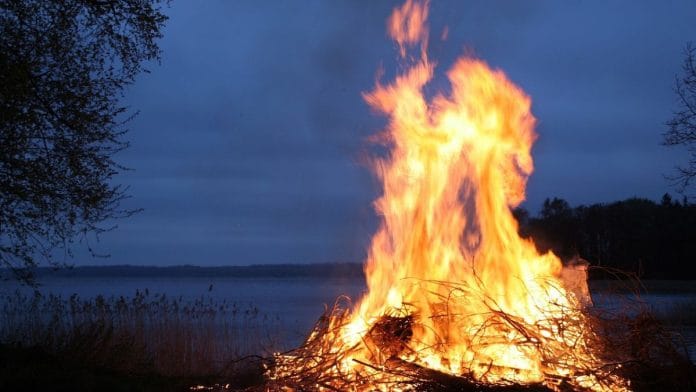Thank you dear subscribers, we are overwhelmed with your response.
Your Turn is a unique section from ThePrint featuring points of view from its subscribers. If you are a subscriber, have a point of view, please send it to us. If not, do subscribe here: https://theprint.in/subscribe/
Tariq Fateh, a Canada-based writer, recently passed away. He had expressed his wish to be cremated before his death, despite being a Muslim who would typically be buried according to his religious customs. His body was therefore consigned to the flames. Tarek Fatah’s daughter Natasha Fatah tweeted on April 28: ‘As per dad’s wishes he was cremated today surrounded by his closest family and friends’.
The issue of death is multidimensional, and as the world’s population continues to grow, questions arise about the environmental impact of traditional funeral practices. The amount of land and wood required, extinction of great scavengers of nature, as well as the use of chemicals, raise concerns about the ecological impact of these practices. With every dead person, either wood is burnt, or some land is sacrificed. The environment also dies a little, and the living inhabitants of the already overburdened earth, where almost 150 million people are homeless, silently and uncomplainingly hand over land and trees to the dead.
Gopal Krishna Gandhi, renowned historian, has written about the irony of Mahatma Gandhi’s funeral procession. Despite his lifelong commitment to non-violence, Gandhi’s body was carried in a vehicle designed for subversive weapons! Although he had requested a simple cremation and was against preservation of the body with the use of chemicals, Pyarelal, Gandhi ji’s secretary mentions in his documents that his cremation used an excessive amount of sandalwood, ghee, incense, coconut shells, and camphor. “Fifteen maunds (a old unit of weight) of sandalwood, four maunds of ghee, two maunds of incense, one maund of coconut shells and fifteen kilos of camphor were used”, in Pyarelal’s words. If Gandhiji had given clear instructions about this, perhaps all this would have been done with a little restraint, as perhaps he himself would have liked. The philosopher J. Krishnamurti, on the other hand, had clear instructions with respect to his funeral, advocating for a simple, non-religious approach. He had instructed his close associates that the body should be treated like a log of wood; after he ceased to exist, the body should be wrapped a clean, but inexpensive piece of cloth and that very few people should see the body. When Socrates was asked by his friends as to how he would like his body to be disposed of, he is said to have replied: ‘First catch hold of the body and make sure that it’s me that you are catching hold of and then do whatever you want to do with it’. Andrew Robinson makes an interesting point in his biography of Satyajit Ray, ‘The Inner Eye’. After the death of Rabindranath Tagore, Satyajit Ray had reached Tagore’s house and saw Nandlal Bose decorating Gurudev’s dead body with white flowers. When the funeral procession started, there was mayhem and one could see flocks of admirers trying to pluck at least one hair of the poet’s beard, for their memory! The Parsis in India used to leave the corpse on the Tower of Peace and allow birds such as vultures to devour the remains. With the extinction of vulture and the resultant loss of one of nature’s most immaculate scavenger, the community has to take a fresh look at its ancient practises and customs.
There are generally two options for the last rites of a deceased individual: cremation or burial. However, some individuals object to the use of wood, given the valuable resources it represents. Traditional Hindus often prefer not to use electric crematoriums and instead rely on traditional practices, including the immersion of bones in nearby rivers. However, this raises questions about river pollution, particularly for those concerned about the environment. Additionally, there are specific customs for sages, young children, and widows in Hindu rituals, who are not cremated but given a Jal Samadhi. Then there is the idea of aquamation. Bishop Desmond Tutu was the first prominent person perhaps to undergo this process. It is a process in which the body of the deceased is immersed for a few hours in a mixture of water and a strong alkali in a pressurized metal cylinder and heated to around 150 degree centigrade.The combination of gentle water flow, temperature and alkalinity result in the breakdown of the organic materials.
In light of concerns about the ecological impact of traditional funeral practices, alternative approaches such as body donation for scientific research, seem worth considering. However, discussions about death are often considered a taboo, and individuals may not feel comfortable discussing their preferences with their loved ones. Political and religious leaders also play a role in shaping public perceptions of death, often opting for grandiose funeral processions that highlight their status even in death. As though, in absence of a huge number of mourners, enormous amount of tears and loud chest-thumping they would not even agree to give up the ghost!
In conclusion, as the world’s population continues to grow, it is essential to consider the ecological impact of traditional funeral practices. There are alternative approaches that may be worth considering. However, to make progress in this area, we need to start openly discussing our preferences around death and move beyond the traditional practices that have been in place for centuries.
*A phrase from the burial service in the Book of Common Prayer: ‘we therefore commit this body to the ground, earth to earth, ashes to ashes, dust to dust; in sure and certain hope of the Resurrection to eternal life.
These pieces are being published as they have been received – they have not been edited/fact-checked by ThePrint.


